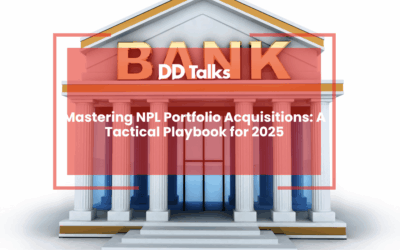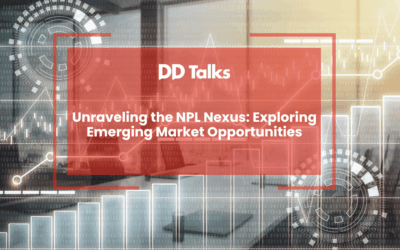Essential Insights for NPL Investment Success
- NPL investments offer attractive returns through pricing inefficiencies, with discounts ranging from 20-80% of face value depending on collateral quality, vintage, and jurisdiction.
- Successful NPL investing requires specialized expertise in three critical areas: accurate valuation methodologies, efficient servicing platforms, and deep understanding of local legal frameworks.
- Institutional investors can access NPL markets through direct portfolio acquisitions, specialized funds, or securitization structures, each offering different risk-return profiles.
- Effective portfolio management—from data enhancement and segmentation to active servicing and strategic exits—represents the primary value creation mechanism in NPL investments.
- Due diligence for NPL fund selection should evaluate track record across market cycles, operational capabilities, risk management frameworks, and alignment of interests.
- Future NPL investment returns will be shaped by digital transformation, ESG considerations, regulatory harmonization, and emerging catalysts for new NPL formation.
Table of Contents
- Understanding Non-Performing Loan Investment Fundamentals
- Key NPL Investment Strategies for Institutional Investors
- How Do Leading NPL Funds Structure Their Acquisitions?
- NPL Portfolio Management: From Acquisition to Resolution
- Special Situations and Opportunistic NPL Investments
- Co-Investment Models in the NPL Marketplace
- Due Diligence Framework for NPL Fund Selection
- Future Trends Shaping NPL Investment Returns
Understanding Non-Performing Loan Investment Fundamentals
Non-performing loans (NPLs) represent a significant investment opportunity within European financial markets. These assets, typically defined as loans where borrowers have failed to make scheduled payments for 90 days or more, create both challenges for banks and opportunities for specialised investors. The European NPL market has evolved considerably since the 2008 financial crisis, with regulatory pressure compelling banks to reduce their NPL ratios and clean up balance sheets.
The fundamental appeal of NPL investments lies in the discount to face value at which these assets trade. Institutional investors acquire these distressed debts at significant discounts, often ranging from 20% to 80% of the nominal value, depending on factors such as collateral quality, vintage, and jurisdiction. This pricing inefficiency creates the potential for attractive risk-adjusted returns when managed by experienced operators with specialised workout capabilities.
NPL investment fundamentals hinge on three critical components: accurate valuation methodologies, efficient servicing platforms, and deep understanding of local legal frameworks. Successful NPL fund managers develop proprietary pricing models that incorporate granular loan-level data analysis, macroeconomic forecasting, and jurisdiction-specific recovery timelines. The complexity of these investments necessitates specialised expertise that extends beyond traditional fixed income analysis.
Key NPL Investment Strategies for Institutional Investors
Institutional investors approach NPL investments through several distinct strategies, each tailored to specific risk appetites and market opportunities. The primary NPL investment strategies include:
Direct Portfolio Acquisitions
Large institutional investors with dedicated workout teams often pursue direct portfolio acquisitions, purchasing NPL pools directly from originating banks. This approach requires substantial capital deployment (typically €100+ million) but eliminates intermediary fees and provides greater control over the resolution process. Direct acquisitions typically target secured NPLs backed by commercial real estate, residential mortgages, or corporate assets.
Fund Investments
For investors seeking diversified exposure to the NPL market, specialised distressed debt funds offer a compelling alternative. These vehicles, managed by experienced NPL fund managers, pool capital from multiple investors to acquire diversified portfolios across geographies and asset classes. Top distressed debt funds typically employ a combination of senior secured, mezzanine, and special situations strategies to optimise returns across market cycles.
Securitisation Investments
NPL securitisation structures have gained prominence, particularly in markets like Italy where the GACS scheme has facilitated significant transactions. Institutional investors can participate by acquiring tranches of NPL-backed securities, with risk profiles ranging from senior investment-grade notes to subordinated equity positions. This approach offers liquidity and standardisation advantages compared to direct portfolio ownership.
How Do Leading NPL Funds Structure Their Acquisitions?
Leading NPL funds employ sophisticated acquisition structures designed to optimise tax efficiency, regulatory compliance, and operational flexibility. The predominant structures include:
SPV-Based Acquisitions
Special Purpose Vehicles (SPVs) represent the most common acquisition structure, with NPL funds establishing jurisdiction-specific entities to hold acquired assets. These SPVs typically incorporate in tax-efficient locations while maintaining compliance with local servicing requirements. The SPV structure creates a bankruptcy-remote vehicle that protects investors from potential liabilities associated with the underlying assets.
Joint Venture Structures
Complex NPL portfolios often necessitate joint venture arrangements between NPL funds and local operating partners. These structures combine the capital resources of institutional investors with the local expertise and servicing capabilities of established market participants. JV arrangements typically include detailed governance provisions, performance incentives, and exit mechanisms to align interests between financial and operating partners.
Forward Flow Agreements
Rather than one-off portfolio acquisitions, some NPL funds negotiate forward flow agreements with banking partners. These arrangements establish predetermined pricing frameworks for future NPL sales, providing banks with certainty regarding their deleveraging plans while giving investors a predictable pipeline of opportunities. Forward flow structures have gained popularity in markets with ongoing NPL formation, such as Greece and Cyprus.
NPL Portfolio Management: From Acquisition to Resolution
Effective NPL portfolio management represents the critical value creation mechanism in the investment lifecycle. The journey from acquisition to resolution encompasses several distinct phases:
Onboarding and Data Enhancement
Following acquisition, NPL managers conduct comprehensive data enhancement processes to verify loan documentation, validate collateral information, and establish accurate borrower profiles. This phase often reveals discrepancies between the seller’s representations and actual portfolio characteristics, requiring adjustments to initial business plans.
Segmentation and Strategy Development
Sophisticated NPL managers segment acquired portfolios into distinct clusters based on borrower characteristics, collateral quality, and legal status. Each segment receives a tailored resolution strategy, ranging from consensual restructuring for viable borrowers to enforcement proceedings for uncooperative cases. This granular approach maximises recovery values while optimising resource allocation.
Active Servicing and Monitoring
The execution phase involves active servicing through dedicated loan servicing platforms, either proprietary or third-party. Leading NPL funds maintain rigorous performance monitoring frameworks, tracking key metrics such as resolution rates, timeline adherence, and cost-to-collect ratios. This data-driven approach enables continuous refinement of resolution strategies and early identification of underperforming segments.
Exit Strategies
NPL portfolio management culminates in the implementation of appropriate exit strategies, including individual loan resolutions, sub-portfolio sales, or securitisation transactions. The timing and structure of exits significantly impact overall investment returns, with managers continuously evaluating market conditions to optimise realisation values.
Special Situations and Opportunistic NPL Investments
Beyond traditional NPL portfolio acquisitions, specialised investors pursue opportunistic strategies targeting unique distressed situations. These special situations often present asymmetric risk-reward profiles for investors with specialised expertise:
Single-Name Distressed Opportunities
Rather than acquiring diversified portfolios, some NPL investors focus on single-name distressed opportunities involving complex corporate situations. These investments typically involve acquiring the debt of specific distressed companies with the intention of influencing restructuring outcomes or potentially converting debt to equity. This approach requires deep sector expertise and often active involvement in restructuring negotiations.
Regulatory-Driven Opportunities
Regulatory developments frequently create time-sensitive NPL investment opportunities. For instance, the European Central Bank’s guidance on NPL management has accelerated disposal timelines for significant institutions, creating motivated sellers in certain jurisdictions. Similarly, changes to insolvency frameworks or foreclosure procedures can dramatically alter the risk-return profile of specific NPL segments.
Platform Investments
Some investors pursue an integrated approach by acquiring not only NPL portfolios but also the servicing platforms that manage them. These platform investments provide operational control over the resolution process while creating potential for recurring fee income. Notable examples include Cerberus’s acquisition of Haya Real Estate in Spain and Bain Capital’s investment in Aquileia Capital Services in Italy.
Co-Investment Models in the NPL Marketplace
Co-investment structures have emerged as an increasingly popular approach to NPL investments, allowing investors to participate alongside established managers while maintaining greater control than traditional fund investments. These models take several forms:
Club Deals
Club deals bring together a limited number of institutional investors to pursue specific NPL opportunities, typically larger portfolios requiring substantial capital deployment. These arrangements allow participants to leverage the origination and execution capabilities of lead investors while maintaining direct exposure to the underlying assets. Club deals often feature bespoke governance arrangements and more favourable economics compared to commingled funds.
Sidecar Vehicles
Established NPL fund managers frequently offer sidecar investment opportunities to their largest limited partners, allowing them to deploy additional capital alongside the manager’s flagship funds. These structures typically focus on specific geographies or asset classes where the manager has identified outsized opportunities exceeding their fund’s capacity. Sidecar arrangements maintain alignment through shared economics while providing investors with enhanced transparency.
Public-Private Partnerships
In several European markets, government initiatives have created structured co-investment opportunities between public entities and private investors. Notable examples include Italy’s GACS scheme and Greece’s Hercules programme, which provide state guarantees for senior tranches of NPL securitisations. These public-private partnerships effectively redistribute risk while accelerating the resolution of systemic NPL problems.
Due Diligence Framework for NPL Fund Selection
Institutional investors conducting due diligence on NPL fund managers should employ a comprehensive framework addressing several critical dimensions:
Track Record Analysis
Rigorous evaluation of a manager’s historical performance should extend beyond headline IRR figures to examine consistency across market cycles, performance attribution by strategy, and comparison of realised versus projected returns. Particular attention should focus on the manager’s experience in relevant jurisdictions, as recovery processes vary dramatically across European markets.
Operational Capabilities
NPL investments demand specialised operational capabilities that distinguish successful managers. Due diligence should assess the manager’s servicing arrangements, data management systems, and workout expertise. The quality and stability of the servicing platform often proves more determinative of investment outcomes than initial acquisition pricing.
Risk Management Framework
Effective NPL investing requires robust risk management frameworks addressing legal, regulatory, reputational, and operational risks. Investors should evaluate the manager’s approach to borrower engagement, compliance with consumer protection regulations, and protocols for handling sensitive personal data. The increasing regulatory scrutiny of NPL investors makes this dimension particularly important.
Alignment of Interests
Fund structures should create meaningful alignment between managers and investors through appropriate carried interest mechanisms, significant GP commitments, and thoughtful fee structures. The most investor-friendly arrangements include hurdle rates calibrated to risk profiles, catch-up provisions, and performance fees calculated on realised rather than unrealised gains.
Future Trends Shaping NPL Investment Returns
Several emerging trends will shape the European NPL investment landscape and influence future returns:
Digital Transformation
Advanced analytics, machine learning algorithms, and digital servicing platforms are transforming NPL management capabilities. Leading investors increasingly leverage technology to enhance borrower segmentation, optimise resolution strategies, and streamline operational processes. This digital transformation is compressing resolution timelines and reducing servicing costs, potentially enhancing overall returns.
ESG Considerations
Environmental, Social, and Governance factors are gaining prominence in NPL investment strategies. Socially responsible approaches to borrower engagement, sustainable repurposing of foreclosed real estate assets, and transparent governance practices increasingly influence investor allocations. Forward-thinking NPL managers are developing ESG frameworks specific to distressed debt investing.
Cross-Border Harmonisation
European regulatory initiatives, including the EU Directive on credit servicers and purchasers, are gradually harmonising NPL markets across jurisdictions. This standardisation may reduce the complexity premium historically available in certain markets while potentially increasing liquidity and transaction volumes. Investors with pan-European capabilities will be best positioned to capitalise on this evolution.
New NPL Formation Catalysts
While the post-financial crisis wave of NPLs has largely been addressed in Western European markets, new formation catalysts are emerging. The economic impact of the pandemic, potential interest rate normalisation, and sector-specific disruptions may generate fresh NPL opportunities. Investors with flexible mandates and diversified expertise will be best positioned to capitalise on these next-generation distressed opportunities.
Frequently Asked Questions
What is a non-performing loan (NPL)?
A non-performing loan (NPL) is a loan where the borrower has failed to make scheduled payments for 90 days or more. These distressed assets are typically sold by banks at significant discounts to face value, ranging from 20% to 80% depending on factors such as collateral quality, vintage, and jurisdiction. NPLs represent both a challenge for banks seeking to clean up their balance sheets and an opportunity for specialized investors with workout capabilities.
How do institutional investors approach NPL investments?
Institutional investors approach NPL investments through three main strategies: direct portfolio acquisitions (purchasing NPL pools directly from banks), fund investments (allocating capital to specialized distressed debt funds), and securitization investments (acquiring tranches of NPL-backed securities). Each strategy offers different levels of control, diversification, and liquidity, allowing investors to align their approach with specific risk appetites and market opportunities.
What structures do NPL funds use for acquisitions?
Leading NPL funds structure their acquisitions primarily through Special Purpose Vehicles (SPVs), joint venture arrangements, and forward flow agreements. SPVs create bankruptcy-remote entities in tax-efficient locations, joint ventures combine institutional capital with local operating expertise, and forward flow agreements establish predetermined pricing frameworks for future NPL sales, providing investors with a predictable pipeline of opportunities.
What are the key phases of NPL portfolio management?
NPL portfolio management encompasses four key phases: onboarding and data enhancement (verifying loan documentation and collateral information), segmentation and strategy development (clustering loans and developing tailored resolution approaches), active servicing and monitoring (executing resolution strategies while tracking performance metrics), and exit strategies (implementing appropriate realization methods including individual resolutions, sub-portfolio sales, or securitizations).
What co-investment models exist in the NPL marketplace?
The NPL marketplace features three primary co-investment models: club deals (bringing together limited institutional investors for specific large opportunities), sidecar vehicles (allowing large limited partners to deploy additional capital alongside a manager’s flagship fund), and public-private partnerships (structured arrangements between government entities and private investors, often featuring state guarantees for senior tranches of NPL securitizations).
What should investors evaluate when conducting due diligence on NPL fund managers?
When conducting due diligence on NPL fund managers, investors should evaluate four critical dimensions: track record analysis (examining performance consistency across market cycles and jurisdictions), operational capabilities (assessing servicing arrangements and workout expertise), risk management framework (evaluating approaches to legal, regulatory, and reputational risks), and alignment of interests (reviewing carried interest mechanisms, GP commitments, and fee structures).
What future trends will shape NPL investment returns?
Future NPL investment returns will be shaped by digital transformation (advanced analytics and technology-enabled servicing), ESG considerations (responsible borrower engagement and sustainable practices), cross-border harmonization (standardization of European NPL markets through regulatory initiatives), and new NPL formation catalysts (economic impacts from the pandemic, interest rate changes, and sector-specific disruptions creating fresh distressed opportunities).




0 Comments